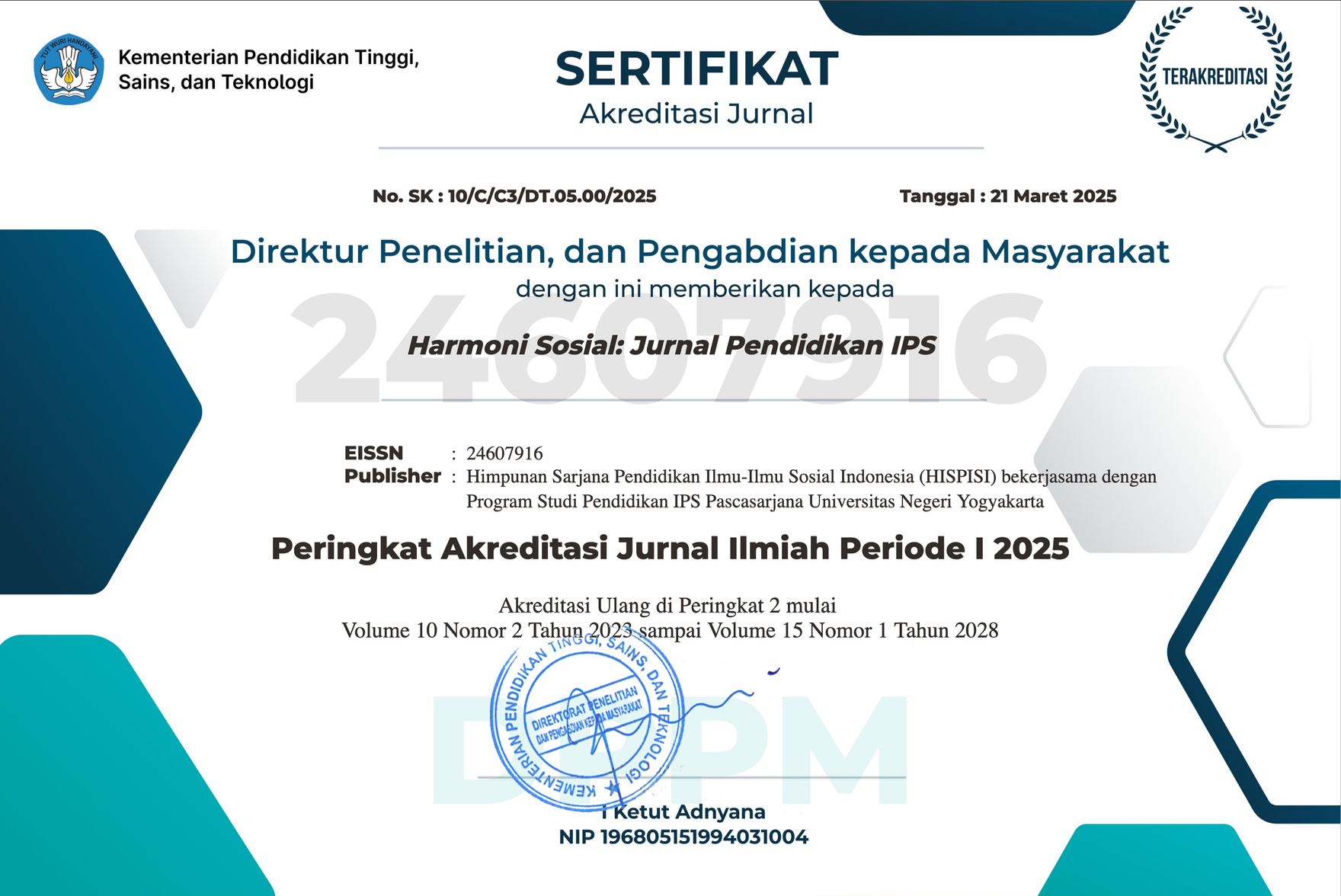Men's role within the women's movement to achieve gender equality in Indonesia: Threat or opportunity?
Downloads
The women's movement, both globally and locally in Indonesia, has organically been trying to eliminate gender inequality caused by patriarchy for a long time. Even though they benefit from patriarchal culture in many ways, men also experience losses and, as a result, are interested in getting involved in the gender equality movement, which women mostly initiate. However, men are in a dilemma position in this women's movement: as a threat and an opportunity. Therefore, this article is qualitative research that explores the potential and risks of men's involvement in the women's movement through a literature review. All the collected articles were then read, and their important findings were formulated in the results and classified thematically. The results show that historically, men have been and continue to be involved in the gender equality movement. However, several pros and cons arise. Therefore, this article also ultimately argues that even though it is significant for men to be involved in the women's movement to end all forms of oppression, domination, and violence, the involvement of men is conditional, which pays attention to the safety of women and is not intended to take over the political position of the leader of the gender equality movement from women.
Downloads
Allen, E., & Bradley, M. S. (2018). Perceptions of harm, criminality, and law enforcement response: Comparing violence by men against women and violence by women against men. Victims & Offenders, 13(3), 373–389. https://doi.org/10.1080/15564886.2017.1340383
Arivia, G., & Subono, N. I. (2017). Seratus tahun feminisme di Indonesia: Analisis terhadap para aktor, debat, dan strategi. Friedrich Ebert Stiftung.
Burcar, V., & í…kerstrí¶m, M. (2009). Negotiating a victim identity: Young men as victims of violence. Journal of Scandinavian Studies in Criminology and Crime Prevention, 10(1), 37–54. https://doi.org/10.1080/14043850902815073
Cameron, L. (2023). Gender equality and development: Indonesia in a global context. Bulletin of Indonesian Economic Studies, 59(2), 179–207. https://doi.org/10.1080/00074918.2023.2229476
Carmo, R., Grams, A., & Magalhí£es, T. (2011). Men as victims of intimate partner violence. Journal of Forensic and Legal Medicine, 18(8), 355–359. https://doi.org/10.1016/j.jflm.2011.07.006
Darwin, M. (2004). Gerakan perempuan di Indonesia dari masa ke masa. Jurnal Ilmu Sosial Dan Ilmu Politik, 7(3), 283–294. https://journal.ugm.ac.id/jsp/article/view/11061
Fakih, M. (2013). Analisis gender dan transformasi sosial (Cetakan Ke). Pustaka Pelajar.
Febrianto, R. F. (2014). Feminisme dan partisipasi laki-laki : analisis frame alignment dalam gerakan laki laki pro feminis (studi sosiologi gerakan sosial mengenai upaya pengorganisasian gerakan aliansi laki-laki baru) [Universitas Indonesia]. https://lontar.ui.ac.id/detail?id=20388147&lokasi=lokal
Flood, M. (2015). Work with men to end violence against women: A critical stocktake. Culture, Health & Sexuality, 17(sup2), 159–176. https://doi.org/10.1080/13691058.2015.1070435
Flood, M. (2019). Gender equality: Engaging men in change. The Lancet, 393(10189), 2386–2387. https://doi.org/10.1016/S0140-6736(19)31295-4
Flood, M., Dragiewicz, M., & Pease, B. (2018). Resistance and backlash to gender equality: An evidence review. QUT Crime and Justice Research Centre.
Flood, M., & Pease, B. (2009). Factors influencing attitudes to violence against women. Trauma, Violence, & Abuse, 10(2), 125–142. https://doi.org/10.1177/1524838009334131
Fulu, E., Warner, X., Miedema, S., Jewkes, R., Roselli, T., & Lang, J. (2013). Why do some men use violence against women and how can we prevent it? Qualitative findings from the United Nations Multi-country Study on men and violence in Asia and the Pacific. UNDP, UNFPA, UN Women, and UNV. https://www.undp.org/asia-pacific/publications/why-do-some-men-use-violence-against-women-and-how-can-we-prevent-it
Hasyim, N. (2014). How far can men go? A Study of the men's movement to end violence against women in Indonesia [University of Wollongong]. https://ro.uow.edu.au/cgi/viewcontent.cgi?article=5422&context=theses
Hasyim, N. (2017). Laki-laki sebagai sekutu gerakan perempuan. Sawwa: Jurnal Studi Gender, 12(1), 79–90. https://doi.org/10.21580/sa.v12i1.1469
Hasyim, N. (2021). Good boys doing feminism: Maskulinitas dan masa depan laki-laki baru. Buku Mojok.
Humm, M. (2002). Ensiklopedia feminisme (M. Rahayu (trans.)). Fajar Pustaka Baru.
Idriss, M. M. (2022). Abused by the Patriarchy: Male victims, masculinity, "Honor"-Based abuse and forced marriages. Journal of Interpersonal Violence, 37(13–14), NP11905–NP11932. https://doi.org/10.1177/0886260521997928
Kaufman, M. (2001). Building a movement of men working to end violence against women. Development, 44(3), 9–14. https://doi.org/10.1057/palgrave.development.1110254
Kennerley, M. A. (2001). Female perpetrators of domestic violence: A continuum of behavior [University of South Carolina]. https://www.proquest.com/openview/bc1qre8jdw2azrg6tf49wmp652w00xltddxmpk98xp/1?pq-origsite=gscholar&cbl=18750&diss=y
Komisi Nasional Anti Kekerasan terhadap Perempuan. (2021). Catatan kekerasan terhadap perempuan tahun 2020 : Perempuan dalam himpitan pandemi: Lonjakan kekerasan seksual, kekerasan siber, perkawinan anak, dan keterbatasan penanganan di tengah Covid-19. https://komnasperempuan.go.id/catatan-tahunan-detail/catahu-2021-perempuan-dalam-himpitan-pandemi-lonjakan-kekerasan-seksual-kekerasan-siber-perkawinan-anak-dan-keterbatasan-penanganan-di-tengah-covid-19
Loney-Howes, R., Mendes, K., Fernández Romero, D., Fileborn, B., & Núñez Puente, S. (2022). Digital footprints of #MeToo. Feminist Media Studies, 22(6), 1345–1362. https://doi.org/10.1080/14680777.2021.1886142
MeToo Movement. (n.d.). Vision and theory of change. Metoomvmt.Org. https://metoomvmt.org/get-to-know-us/vision-theory-of-change/#:~:text=by%3A Chona Kasinger-,The 'me too.,violence%2C that's when change happens.
O'Neill, R. (2022). Notes on not knowing: Male ignorance after #MeToo. Feminist Theory, 23(4), 490–511. https://doi.org/10.1177/14647001211014756
Oyediran, K., Spencer, C. M., & Stith, S. M. (2023). Men as victims of intimate partner violence in Cameroon and Sierra Leone. Journal of Interpersonal Violence, 38(5–6), 5211–5235. https://doi.org/10.1177/08862605221120883
PettyJohn, M. E., Muzzey, F. K., Maas, M. K., & McCauley, H. L. (2019). #HowIWillChange: Engaging men and boys in the #MeToo movement. Psychology of Men & Masculinities, 20(4), 612–622. https://doi.org/10.1037/men0000186
Pradita, S. M. (2020). Sejarah Pergerakan Perempuan Indonesia Abad 19–20: Tinjauan historis peran perempuan dalam pendidikan bangsa. CHRONOLOGIA, 2(2), 12–27. https://doi.org/10.22236/jhe.v2i2.6060
Simaibang, E. W. A., & Bajari, A. (2019). Representasi male feminist oleh aliansi laki-laki baru di media sosial. Linimasa : Jurnal Ilmu Komunikasi, 2(2), 12–27. https://doi.org/10.23969/linimasa.v2i2.1685
Suhada, D. N. (2021). Feminisme dalam dinamika perjuangan gender di Indonesia. Indonesian Journal of Sociology, Education, and Development, 3(1), 15–27. https://doi.org/10.52483/ijsed.v3i1.42
Wieringa, S. (2010). Pasang surut gerakan perempuan Indonesia. In Perempuan dalam Relasi Agama dan Negara. Komisi Nasional Anti Kekerasan terhadap Perempuan. https://pure.uva.nl/ws/files/1484986/117107_337342.pdf
The Authors submitting a manuscript do so on the understanding that if accepted for publication, copyright publishing of the article shall be assigned to Harmoni Sosial: Jurnal Pendidikan IPS
 | Harmoni Sosial: Jurnal Pendidikan IPS by http://journal.uny.ac.id/index.php/hsjpi is licensed under a Creative Commons Attribution-ShareAlike 4.0 International License. |










 ISSN Print
ISSN Print









